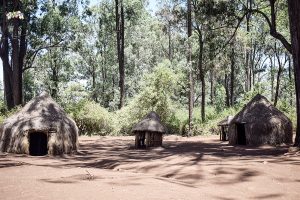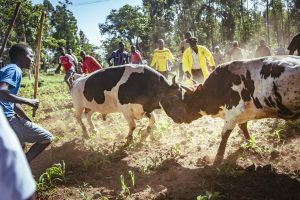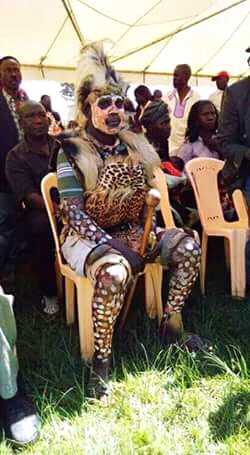Introduction
The Luhya people constitute one of Kenya’s largest ethnic groups, representing a fascinating collection of closely related Bantu-speaking communities in Western Kenya. Far from being a monolithic entity, the Luhya comprise between 18 and 20 distinct sub-tribes, each maintaining unique cultural practices while sharing common linguistic and cultural foundations. These communities, including the Bukusu, Wanga, Maragoli, Tiriki, Kabras, Isukha, Idakho, and others, have developed rich traditions that reflect their individual identities and collective heritage.
The term “Luhya” itself serves as both an ethnolinguistic designation and a political unification concept that emerged in the mid-20th century. While these communities lacked a common origin story, their shared cultural practices, languages, and geographical proximity in Western Kenya have created a cohesive cultural identity that continues to evolve in contemporary times.
Social Organisation and Family Structure

Luhya society is fundamentally patrilineal, with inheritance and lineage traced through the male line. Traditional family structures emphasised extended family networks, where multiple generations lived nearby, creating strong social bonds and mutual support systems. Marriage customs traditionally included bride price negotiations, with cattle serving as the primary medium of exchange.
The practice of polygamy was historically common among the Luhya, particularly among wealthy men who could afford multiple wives. However, with the widespread adoption of Christianity throughout the 20th century, monogamy has become the predominant marriage pattern, though some communities still practice polygamy under traditional African or Islamic law.
Religious Beliefs and Practices

The Luhya spiritual landscape reflects a complex blend of traditional African religions and introduced faiths. Ancestral veneration formed the cornerstone of traditional Luhya spirituality, with elaborate rituals honouring deceased family members believed to influence the living. Sacred groves, rivers, and mountains served as spiritual centres where communities conducted ceremonies and sought divine intervention.
Christianity has profoundly influenced modern Luhya religious practices, with both Catholicism and Protestantism widely embraced. However, this adoption has not completely displaced traditional beliefs. Many Luhya people practice religious syncretism, combining Christian worship with traditional spiritual practices. The Dini ya Msambwa movement, founded by Elijah Masinde, exemplifies this fusion of Christian and traditional elements.
Arts and Crafts

Luhya artistic traditions encompass various forms of creative expression that serve both aesthetic and functional purposes. Pottery making remains a vital craft, particularly among women, who create vessels for storing water, cooking, and serving food. These ceramic works often feature intricate designs that reflect local artistic traditions and cultural symbolism.
Basket weaving represents another significant artistic practice, with artisans utilising materials such as date palm leaves and, increasingly, sisal fibre. These baskets serve practical purposes for storage and transport while showcasing the weaver’s skill and creativity. Body ornaments, including bangles, necklaces, and earrings, demonstrate the community’s appreciation for personal adornment and social status expression.
Music and Dance
Music and dance occupy central positions in Luhya cultural expression, serving as vehicles for storytelling, spiritual communication, and social bonding. Traditional instruments include drums, flutes, and stringed instruments accompanying various ceremonial and social occasions. Dance performances often incorporate elaborate costumes and choreographed movements that tell stories of historical events, seasonal changes, or spiritual encounters.
Luhya Sub-Tribes: Cultural Diversity and Seasonal Practices
| Sub-Tribe | Primary Location | Notable Cultural Practice | Traditional Ceremony Month | Signature Cuisine |
| Bukusu | Bungoma County | Circumcision with elaborate rituals | August | Ugali with chicken, traditional vegetables |
| Wanga | Mumias, Kakamega | Traditional kingship system | Various seasons | Fish from River Nzoia, millet porridge |
| Maragoli | Vihiga County | Pottery and basket weaving | September-October | Sweet potatoes, traditional greens |
| Tiriki | Vihiga County | Itumbi circumcision ceremony | August (every 5 years) | Finger millet, traditional herbs |
| Kabras | Malava, Kakamega | Masked circumcision rituals | August | Ugali, indigenous vegetables |
| Isukha | Kakamega County | Rainmaking ceremonies | March-April | Sorghum, traditional stews |
| Idakho | Kakamega County | Funeral rites and ancestral veneration | Year-round | Millet bread, local fish |
| Kisa | Kakamega County | Traditional healing practices | Various seasons | Traditional porridge, local greens |
| Marama | Kakamega County | Pottery and traditional crafts | October-November | Cassava, an indigenous vegetable |
| Tsotso | Kakamega County | Traditional storytelling | December-January | Finger millet, traditional stews |
| Nyole | Kakamega County | Fishing and water rituals | February-March | Fresh fish, traditional vegetables |
| Samia | Busia County | Cross-border trade traditions | Various seasons | Fish, cassava, traditional greens |
Traditional Cuisine and Dietary Practices
Luhya cuisine reflects the agricultural abundance of Western Kenya and the community’s deep connection to the land. Staple foods include various grains such as finger millet, sorghum, and maize, which are prepared in numerous ways to create nutritious and flavorful meals. Ugali, a thick porridge made from maize flour, serves as the primary carbohydrate source and is typically accompanied by various vegetables and proteins.
Traditional vegetables play crucial roles in Luhya nutrition, with indigenous greens like managu, terere, and kunde providing essential nutrients and distinctive flavours. These vegetables are often prepared with groundnuts or small fish to create balanced, protein-rich meals. Sweet potatoes, cassava, and bananas serve as important supplementary carbohydrates, particularly during times when grain harvests are limited.
Protein sources traditionally included domestic animals such as cattle, goats, and chickens, though these were often reserved for special occasions and ceremonies. Fish from local rivers and Lake Victoria provided more regular protein, particularly for communities living near water sources. Traditional food preservation methods, including smoking and drying, ensured food security throughout the year.
Conclusion
The Luhya people of Kenya represent a remarkable example of cultural diversity within unity, maintaining distinct sub-tribal identities while sharing common values and practices. Their rich traditions, from pottery and basket weaving to elaborate circumcision ceremonies, demonstrate the continued vitality of African cultural heritage in contemporary times.

